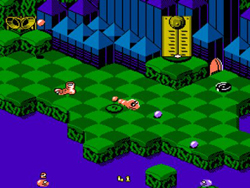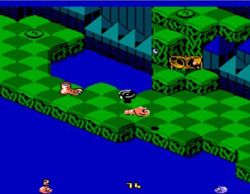
As much as people discuss the emergence of casual audiences today, the 8-bit Nintendo era was the perfect casual crossroads in videogame technology from my nostalgic vantage point. It was far more cost efficient than the computers of the day, with the savings far out-weighing what those computers could offer the casual consumer for entertainment. It also offered the potential for more complex types of games than the vastly inferior blocks and bleeps of the earlier Atari 2600 and other contenders prior to the infamous crash of the industry.
And as the NES found its way into more living rooms, it became an ideal platform for the ultimate casual player time-sink; puzzle games.
From my own childhood, I can comfortably say that the release of the NES version of Tetris caused a massive influx of casual gaming interest. Different from the Wii boom, this was still a time when videogames were viewed as little more than children’s toys, and as a result this first casual revolution did not serve to sell more Nintendo consoles to casual players but instead saw game time on your own Nintendo eroded, chiefly by your parent’s newly sparked interest in your toy.

Over its lifespan, the NES saw some of the most beloved and enduring puzzle games in history grace its 72-pin connector. Titles such as Tetris (the GameBoy iteration is arguably the greatest videogame ever made), Dr. Mario, Yoshi, and Yoshi’s Cookie, Irem’s Kickle Cubicle, Lode Runner, Solomon’s Key, and even such action/puzzle hybrid games as The Adventures of Lolo, Rainbow Islands, and Bomberman.
Of course there is one puzzle game I feel rises above all the rest, and remains today one of the greatest and most under-appreciated from that era.
Released by Nintendo in July 1990, and developed by famed studio Rare, Snake Rattle ‘n’ Roll stands alone in its unique action/puzzle gameplay offering. Taking a page from Atari’s 1984 coin-op Marble Madness, Snake Rattle ‘n’ Roll’s gameplay takes place on a colorful multiscreen isometric grid, complete with platforms and terrain.
You play as a snake, navigating these multi-leveled isometric playing fields in search of “Nibbley Pibbleys”, small sphere like creatures, which you eat. Consuming nibbley pibbleys increases the overall length of your snake ,and thereby increases the amount of damage you can take.

After enough nibbley pibbleys are eaten, your now lengthened body will begin to blink, signalling that you can now exit the stage. Your biggest threats are environmental hazards such as spikes and pits, and the various enemies that roam the levels. When damaged, you risk losing segments of your body. Preventing this at all costs is important, because after finding the exit to a level, you can only unlock the door by first standing on a weight scale located nearby. If you are too light, the exit remains sealed and you must hunt for more nibbley pibbleys.
The game features 11 stages of increasing difficulty, with the stages past 4 becoming brutally hard. But the difficulty of the game is such that you never feel that you are killed unfairly, and part of the fun of the game is finding the easiest way to clear each stage. None-the-less, Snake Rattle ‘n’ Roll is an extremely challenging, yet oddly addictive, hybrid action puzzle title.
Snake Rattle ‘n’ Roll added another dimension to the gameplay with multiplayer co-op, something not often seen in puzzle games of the era. With a second player working to clear stages, the mode adds an additional element of strategy– trying to keep both snakes well fed makes the co-op more competitive than co-operative at times. Success, however, is determined by having both players finish each level, so it is imperative that you strike the correct balance.

If you manage to make it to the end of the game, you’re treated to a screen hinting at a sequel called Snakes in Space. Though such a sequel was never released, a portable version did see the light of day on Nintendo’s GameBoy. However, the gameplay style was altered from an isometric puzzle game to a side-scrolling platformer, killing off much of the charm and challenge that made the original so special.
If you are looking for something different, Snake Rattle ‘n’ Roll is a true gem, and is worthy of a thorough play-through even today. The addicting, fast paced gameplay and bright, colourful environments make this a high watermark in the NES’s game library worth the revisit.
Still own this cartridge. Oh how fun it was to pop into my NES and try to see on what level I would finally die. Prepared me for Battletoads hehehe.
Comment by EdEN — May 9, 2011 @ 6:21 pm
“famed studio Rare” this is something I’ve never understood…
Comment by Ujn Hunter — May 9, 2011 @ 7:30 pm
Great writeup.
Back in the mid-90’s, a friend sold me his NES and a box of cartridges for a hot dog and pop. I passed on Snake Rattle’n’Roll for years, thinking that it was just some crap G-rated game that he had bought as a child. It wasn’t until a few years ago that I popped it in, and gave it a go with one of my friends. We played co-op for hours, and I count it among my fave NES titles. Glad to see this game is finally getting its due.
Comment by Chris Lepine — May 9, 2011 @ 8:19 pm